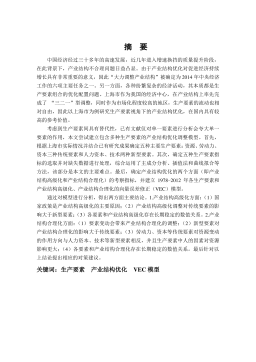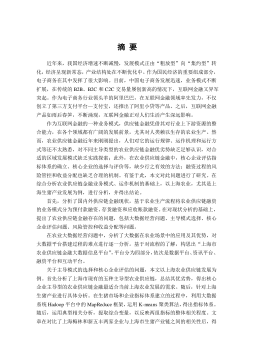金融危机背景下中国钢铁业面临的挑战与应对战略研究
摘要2008年的金融危机对世界经济乃至中国经济都产生了负面影响,并通过对实体经济的传导机制影响了中国钢铁产业的发展,使中国的钢铁企业面临国内外市场需求萎缩、钢材价格下跌,而铁矿石原料进口价格居高不下反而上涨的困境,一些企业纷纷减产甚至停产。由此,对金融危机背景下我国钢铁产业面临的问题及应对战略的分析显得尤为重要。本文在对钢铁产业相关理论、金融危机对实体经济影响的传导机制和国内外相关文献进行综述的基础上,对金融危机前后中国钢铁产业现状及以钢铁为主要需求的下游产业的现状进行了分析,并基于VAR模型对中国的钢铁需求进行了实证分析,模型选取GDP和钢材表观消费量这两个指标,分析了两者之间的关系,得出了...
相关推荐
-
我国基层财政困难的制度成因分析与对策研究VIP免费

 2024-09-20 33
2024-09-20 33 -
我国煤电产业链纵向交易合约机制研究VIP免费

 2024-09-20 28
2024-09-20 28 -
生产要素视角下的上海市产业结构优化研究VIP免费

 2025-01-09 7
2025-01-09 7 -
我国银行业结构与经济结构关系研究VIP免费

 2025-01-09 7
2025-01-09 7 -
大数据视角下农业供应链金融研究VIP免费

 2025-01-09 6
2025-01-09 6 -
跨国大型综合超市的规划研究VIP免费

 2025-01-09 6
2025-01-09 6 -
跨境电商农产品质量安全问题研究VIP免费

 2025-01-09 7
2025-01-09 7 -
世界市场的虚拟化与我国国际电子商务发展方向研究VIP免费

 2025-01-09 9
2025-01-09 9 -
中国政府对电力行业的价格规制问题研究VIP免费

 2025-01-09 14
2025-01-09 14 -
中小企业信息化系统集成技术研究VIP免费

 2025-01-09 14
2025-01-09 14
相关内容
-

跨国大型综合超市的规划研究
分类:高等教育资料
时间:2025-01-09
标签:无
格式:PDF
价格:15 积分
-

跨境电商农产品质量安全问题研究
分类:高等教育资料
时间:2025-01-09
标签:无
格式:PDF
价格:15 积分
-

世界市场的虚拟化与我国国际电子商务发展方向研究
分类:高等教育资料
时间:2025-01-09
标签:无
格式:PDF
价格:15 积分
-

中国政府对电力行业的价格规制问题研究
分类:高等教育资料
时间:2025-01-09
标签:无
格式:PDF
价格:15 积分
-

中小企业信息化系统集成技术研究
分类:高等教育资料
时间:2025-01-09
标签:无
格式:PDF
价格:15 积分





